I had the next day to spend at the Freycinet National Park and the main attraction there is the Wineglass Bay. So I went there. The path is slightly strenuous at first, since the bay is separated from the start of the path by a couple of small mountains. So you need to walk up from 40 meters to the lookout at 200 meters before descending back to sea level. Not a serious climb, but in effect it is like climbing a 40 story staircase and it takes some time. But you get a good look at Wineglass Bay from up there. Wineglass Bay itself seems to have some sort of personal seagull service. At least when I was sitting there at the beach, one seagull kept walking around me, looking at me from all sides. It probably just wanted something to eat, which I hadn't with me, but it was kind of odd that it was just that one seagull staying next to me and walking in circles around me, even though there was nothing to feed it.
After a while the weather turned from sunny to overcast, so it was time to move on. Basically there are two choices. Either go 200 meters up the hill and then 160 meters down again, or cross the isthmus to Hazards Beach and then walk along the coastline back to the car park. That way is a bit longer, but it's more or less level and you get to see new areas instead of retreating your steps. Oddly enough, the info signs there suggest that you return the way you came, even if you're already at Hazards Beach. While this is indeed a bit shorter (4.85 km return distance versus 6 km to complete the circle), it's a strange advice, since for me not having to walk uphill to 200 meters and seeing new and different landscapes far outweigh the need to walk about a kilometer more.
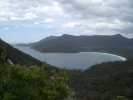
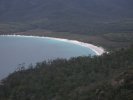
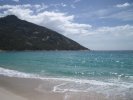
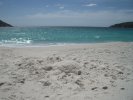
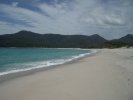
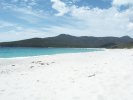
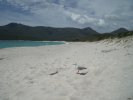
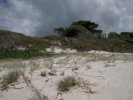
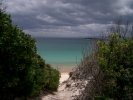
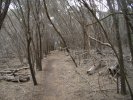
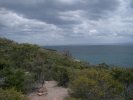
After returning to the lodge, booking the evening entertainment and having a bite, I walked a couple of kilometers along the coast in the late afternoon and spotted the first local wildlife 'in the wild'. The pictures are a bit misleading. If you look at them, it seems that the kangaroos (or wallabies or pandemelons - I can't tell them apart) are pretty well camouflaged and hard to spot. But in real life their movements were so exaggerated and obvious that it would have been hard not to notice them. (If something the size of an average dog jumps up and down in the woods, it just will be noticed, regardless of colour.) A bit later I was sitting on the veranda of my cabin, writing some postcards when there was some noise behind the cabin that sounded as if someone was beating dust from a carpet or hitting his shoes against the floor to remove some dried mud. Then there was a bit of silence and a while later another few thumping noises. Didn't give that much attention until the thumping became louder and a kangaroo crossed in front of me and vanished into the bushes.
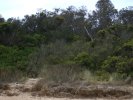
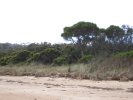
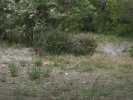
Later there was some rain on the other side of the bay, which looked nicely dramatic.
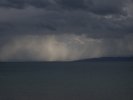
Then it was off to the evenings entertainment. About 40 km north of Freycinet National Park is a town called Bicheno, where a penguin rookery is located. The penguins are out in the ocean all day and only return to the rookery after sunset, so you can only watch them at night. The trip itself was kind of irritating. Photography and videotaping is permitted, but flash photography isn't. (The reasons given for that seem kind of odd and are most likely complete nonsense. Supposedly penguins have no eyelids, so they can't protect themselves against the flash and their eyes take damage. According to this, either all pictures of humans taken with a flash should shown them with closed eyelids or the world should be full of blinded people. Another story had it that penguins are nocturnal and can't close their pupils properly, so the flash hurts their eyes. Which completely ignores that they are out all day on the ocean, which includes days of bright sunlight, with no shade at all. So if a flash from a camera would hurt their eyes, they wouldn't be able to stand a sunny day on the ocean. I am perfectly willing to accept not to photograph the penguins with flashlight since it might irritate or disturb them or make them nervous, and I really think it's a good idea not to allow flash photography around them, but being given fake, pseudo-scientific reasons as a rationale for prohibiting things just irks me.)
The really annoying thing was that the tour guides completely ignored photographers and people with video cameras on the tour. They used flashlights and pointed out penguins, but basically jumped from penguin to penguin with the light, which was extremely frustrating if you tried to take a decent picture. The light shines on one penguin. You find the penguin in your viewfinder (which is not as easy as it sounds, since you're at maximum zoom, since you're not allowed to get close to the penguins and it's night, so if you can't see the penguin through the camera, you don't know where the camera is pointing relative to the penguin), try to focus and the guide shines the light on some other penguin ten meters away. Repeat that for about thirty times and it gets really annoying. I would have been much better if they explicitly disallowed any kind of photography, since then I could have just enjoyed the evening and watched the penguins or cater to the needs of photographers and maybe offer a special 'photo tour' or at least keep the light shining on a couple of penguins for more than a few seconds. But allowing photographs in the first place, but then giving hardly any opportunity to take them is the worst of it, since it takes all enjoyment out of the tour, since you try all the time to get at least some sort of reasonable picture and by the time you're frustrated enough to give up photographing, put the camera away and enjoy the show, the tour is over. This should have been a great evening and there were quite a lot of penguins and it all was pretty amazing, but I just went back fairly disappointed.
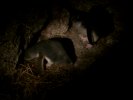
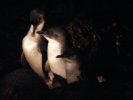
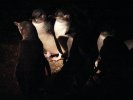
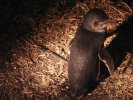
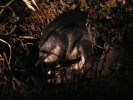
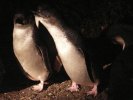
The way back to Freycinet National Park took surprisingly long. There is quite a lot of wildlife to seen in the middle of the night, most of it standing in the middle of the road and uninterested to move away. After that I avoided driving after dark. Either you were very likely to run over some animal or you had to drive so slow that one hour daytime driving would turn into almost three hours at night. Most people seemed to prefer the former choice. Most of the roads in Tasmania and New Zealand had lots of dead animals on them. For a while I wondered whether there might be some big plan behind it to save on concrete and asphalt and pave the streets with fur instead.
Next day I drove on to St.Helens. Did a bit of a detour on the way there. You can either drive directly along the coast or you can drive a street up a mountain to Elephant Pass and another street down again. The advantage of this is the better scenery, the fun of driving winding mountain roads that you almost have to yourself and that you can stop for pancakes. On the hillside there's Mount Elephant Pancake Barn, which, according to its sign has "Good food - fresh coffee. Relax. No Arts, No Crafts, No Souvenirs". It suffers a bit from being more famous than it's good for it (it even has a a special boxed article in the "Lonely Planet" guide) and the claim that it has "something of the British Raj about it" seems to be more influenced by the name than the actual place or the view, but, except for the 'humorous' warning sign at the parking lot, it is a nice place to stop and the pancake and the coffee really are good.
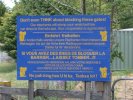
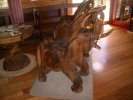
Nothing special at St.Helens (except a motel that hadn't been modernized for so long that it still hat phones with a circular dial - I'm not complaining, the motel was fine, it just struck me as odd and noticeable), but I spent a nice afternoon at the coast.
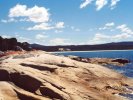
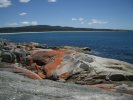
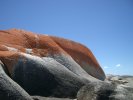
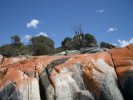
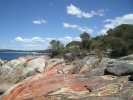
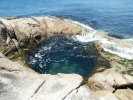
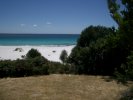
On the way to Launceston I did a bit of a detour to St.Columba Falls. While there's about five kilometer of gravel road on the way (which I don't like much), it's worth it. Interesting forest path to the waterfall, a couple of tourists around, but few enough to enjoy the waterfall alone for a while - nice. There is another waterfall (Ralph's Fall) about 11 kilometer further on along on gravel and dirt roads, but since it's on a scenic circle, I won't have to drive 16 km back on gravel roads, but just a couple of kilometers onwards to Ringarooma, which is also a shortcut to the A3 to Launceston. So I decide to drive to Ralph's Fall. The waterfall itself is a disappointment. Just a single jet of water running down a cliffside, but the circle walk to the waterfall has some interesting and fast changing scenery, so the trip is worth it. But when I get back to the parking lot and try to drive to Ringarooma, I find out that the road is closed, so I have to drive all the way back on gravel roads and then get to the A3 and drive all that distance again in the other direction. I pass Ringarooma about an hour later than expected. But then I'm on vacation and I'm not in a hurry and the car is still ok.





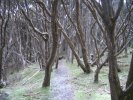
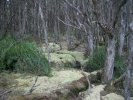
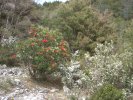
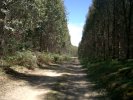
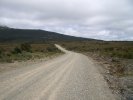
In Launceston the main attraction is Cataract Gorge. I'll go on a short cruise to get a bit of an overview. It's just a small boat and the cruise just goes up and down Tamar River, South Esk and North Esk for a bit, but I enjoy sitting back and relaxing before I walk the cataract walk to the first basin. The main attraction here is a chairlift crossing the basin. Supposedly it's (with 308 meters between the supports) the greatest single span of any chairlift in the world. I'm not entirely comfortable with heights and I pretty much dislike chairlifts, but tried it anyway. Surprisingly I was much more uncomfortable with it over land than when it crossed the water. After the chairlift I used the suspension bridge across the gorge. Later I went back to Launceston using the zig-zag track. (On one side of the river is the cataract walk, which is lit in the evening, mostly level and well maintained, on the other side is the zig-zag track, which is basically just a path going up the hill and down again.)
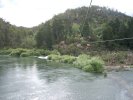
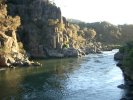
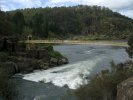
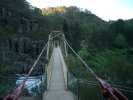
Before describing where I drove the next day, I probably need to explain something. A couple of years ago I was involved in a project were we developed some software called "Penguin". (The reason for the name is a bit obscure. On the NeXT computer there was a font that, if you put two specific letters next to each other, showed a penguin. Since this made it easy to put a little iconic penguin in documents, the software was named because of this.) This project (actually a group of projects) lasted a while and penguin related stuff started to pop up on desks and walls in the offices. Later in the project I noted a web site called the "Big Penguin FAQ" that had stuff about a big penguin memorial in a town named Penguin. So the big penguin became a bit of a virtual patron saint of the software. And was forgotten.
When I prepared for the vacation, I suddenly noticed that the town "Penguin" was in Tasmania. So even though it was a detour, I felt that I had to go there. I even brought a copy of the "Penguin" software and, as a sort of formal end to the Penguin project, sacrificed it to the Big Penguin (well, I not-very-ritually disembowled a floppy disk [yes, the program was written that long ago] and threw it in the next penguin decorated waste basket).
The whole thing felt even sillier than I expected it to be, since the penguin was dressed in a red robe, which made it look even more ridiculous than just a big concrete penguin statue. Anyway, that's the reason why I drove to Penguin and for the penguin related pictures that follow. (I never claimed it was a sensible reason - I was on vacation after all...)
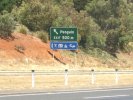
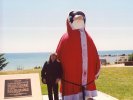



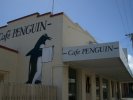

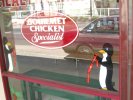
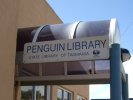
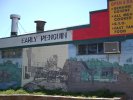
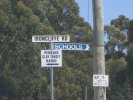
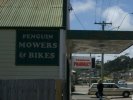
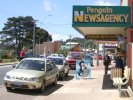
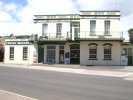
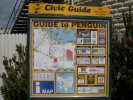
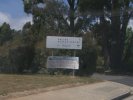
After visiting Penguin I drove to my original destination for the day, Cradle Mountain National Park.